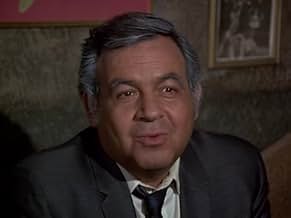Rod Serling présente des histoires d'horreur illustrées dans diverses peintures.Rod Serling présente des histoires d'horreur illustrées dans diverses peintures.Rod Serling présente des histoires d'horreur illustrées dans diverses peintures.
- Nommé pour 2 prix Primetime Emmy
- 2 victoires et 4 nominations au total
Parcourir les épisodes
Histoire
Le saviez-vous
- AnecdotesArtist Thomas J. Wright painted all of the paintings used to introduce each story.
- Citations
Rod Serling: For those of you who've never met me, you might call me the under-nourished Alfred Hitchcock.
- Autres versionsMajor changes were made to most episodes for syndication. The 60-minute episodes were edited down to 30 minute packages, with major edits to some of the 30-40 minute segments of the original shows. In cases of segments that were only 15-20 minutes in length, these were padded out by adding stock footage, newly shot scenes, and footage from Hollywood movies such as Et la terre survivra (1972) and Fahrenheit 451 (1966). Most musical cues were also replaced for syndication. In order to augment "Night Gallery"'s syndicated run, episodes of The Sixth Sense (1972) were edited down to 30 minutes, had new introductions by Rod Serling tacked on, and were added to the syndicated run of "Night Gallery."
- ConnexionsEdited from Four-In-One (1970)
Commentaire en vedette
Often lost in the shadow of Rod Serling's first series, "The Twilight Zone," "Night Gallery" was a fascinating experiment in the anthology format. Instead of one story per episode, the hour was splintered into two, three, or four different stories of varying length. Some were quite brief, lasting no more than a minute; others lasted over 40 minutes. The quality often varied, too. A few of the little vignettes were quite bad. Some stories were quite good. And on more than a few occasions, this little mini-film festival on Wednesday nights produced segments that were as good as anything else on TV at the time. Classic episodes included "They're Tearing Down Tim Riley's Bar," "Pickman's Model" (both nominated for Emmys), "The Caterpillar," "Class of '99," "Green Fingers," "The Messiah on Mott Street," "The Sins of the Fathers," "The Doll," "Cool Air," "Silent Snow, Secret Snow," "A Question of Fear," "The Little Black Bag," and "The Dead Man." Because one of these classics could often be followed or preceded by a story of lesser quality, the series got a reputation for being wildly uneven. It was universally lambasted during its network run by near-sighted critics who were thrown off by its inconsistency, and missed the quality elements: intelligent, stylish writing by Serling and others, top-notch production values (particularly in cinematography and music), and innovative directorial touches. For its syndication run, the series segments were butchered to fit into a half-hour time slot, some losing half their length in the editing, and is a travesty, a mere shadow of its former self. Episodes of a boring ESP potboiler, "The Sixth Sense," were annexed into the syndie package with terrible results. Stick to the uncut version.
- sskelton
- 25 avr. 2002
- Lien permanent
Meilleurs choix
Connectez-vous pour évaluer et surveiller les recommandations personnalisées
- How many seasons does Night Gallery have?Propulsé par Alexa
Détails
- Date de sortie
- Pays d’origine
- Langue
- Aussi connu sous le nom de
- Rod Serling's Night Gallery
- Lieux de tournage
- société de production
- Consultez plus de crédits d'entreprise sur IMDbPro
- Durée50 minutes
- Mixage
- Rapport de forme
- 1.33 : 1
Contribuer à cette page
Suggérer une modification ou ajouter du contenu manquant

Lacune principale
By what name was Night Gallery (1969) officially released in India in English?
Répondre































